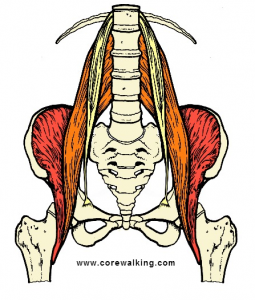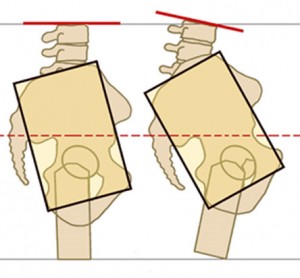The Rhomboid muscles connect the shoulder blade to the spine at the back.
The psoas major connects the spine to the legs from the front. If your pelvis is properly aligned (untucked), the psoas work like a pulley system to help lengthen and extend the spine.
The pulley system works because the psoas attaches at the back of the body and crosses the front of the pelvis creating the tension that helps to support the spine. The hip bone is the pulley and the psoas is the rope.
When the psoas works as a pulley the erector spinea muscles of the back body lengthen the spine upwards. If your pelvis is tucked under the bottom of the psoas, it moves forward and the tension that creates the pulley action disappears.
What does this have to do with the rhomboid muscles you ask? Tuck your pelvis under and see for yourself.
The ideal position of the shoulder blades finds them equidistant from the spine and parallel to each other at their upper border.
When the pelvis tucks under and the psoas can no longer assist the erector muscles of the spine to extend up, the shoulder blades are pulled apart and the rhomboid muscles are pulled wider apart than they need to be.
This is the environment that I find most people live in—rhomboid muscles that are too long and tend towards weakness.
This happens because of the position of the pelvis and lack of pulley action in the psoas.
Many people are trying to figure out their posture by taking their shoulders backward instead of realigning the pelvis.
For me taking the shoulders back creates of false sense of good posture because it creates tone in the rhomboid muscles that can’t be sustained if the pelvis is misaligned.
The two things that need to happen are untucking the pelvis which allows the psoas to do its thing and creates a better more natural placement of the shoulder blades, and, building tone in the rhomboids through exercises.
If these things happen no one will need to hold their shoulders and arms up and back because they will be naturally aligned.
Posture needs to develop from the placement of the pelvis not created from taking the arms and shoulders, and in turn the rhomboid muscles, where we think they should be.
Posture should be the natural result of good skeletal alignment and balanced muscle tone. Not something we are actively creating by holding ourselves in place.



